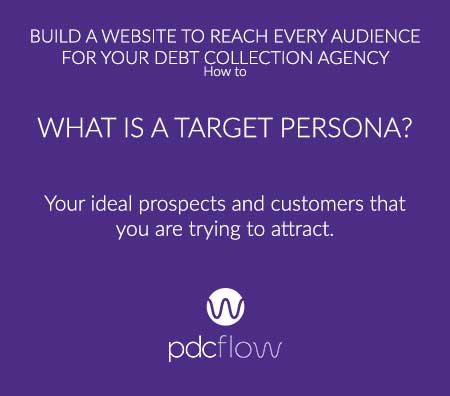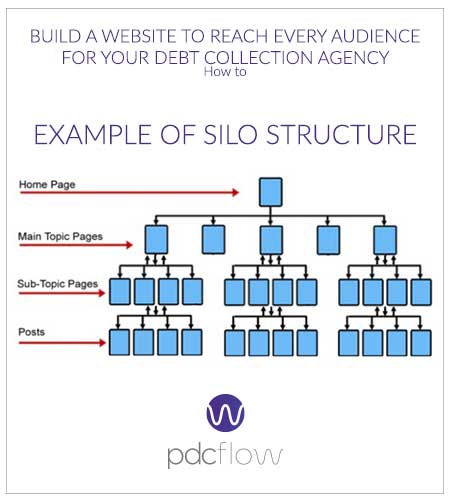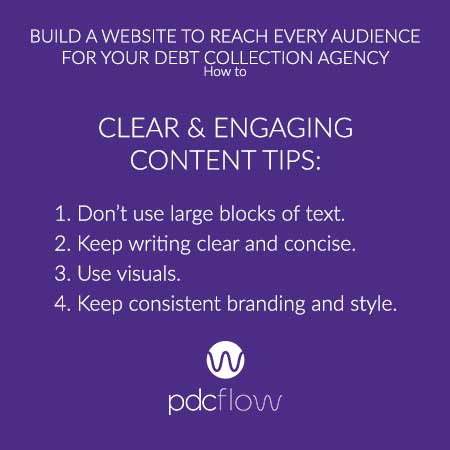By now, every legitimate business should have a working website. Debt collection agencies are no exception.
The objectives your debt collection agency website should achieve, however, are unique.
Debt collection agencies have three main purposes:
- help consumers resolve their debts
- attract new clients to grow your business
- hire new staff members
The challenge is understanding how to build a website that can accomplish all three of these goals.
While it is a challenge, it isn’t impossible. Understanding the intent behind your debt collection website and learning some basic tactics can boost your reputation.
You Only Need To Build One Website
Before you begin to create or redesign your agency website, it’s important to understand that you only need one.
It may seem logical to split your business development website apart from any consumer-facing components. This can be done effectively within one site, so it’s unnecessary to try to separate these parts.
If that isn’t convincing enough, though, there are other compelling reasons you should only associate one website with your business.
Resources
Time - Planning and creating a website takes time. After it’s fully operational, it also needs to be maintained. Many debt collection agencies (especially small to mid-sized ones) don’t have the time or resources to spend on keeping two websites running.
Money - If your company pays web designers to build your site, separate sites double that cost. How else could your agency use that money?
SEARCH ENGINE OPTIMIZATION
Getting your site to rank on page one of Google is hard. To rank without paying for ads, you must use keywords that tell Google why your website is relevant to searchers.
If you split your company aims in two, the websites you create will compete with each other to rank for the same spots and keywords. You’ll find yourself working twice as hard with fewer positive results.

Persona Targeting
So, how do you maintain a single website that can fulfill all of your objectives?
In marketing, persona targeting means tailoring your message so it is relevant to your audience.
In a webinar hosted by Accounts Recovery, experts discussed making the most of your website and how speaking to each audience is the key to a successful site.
Julie Huges, Senior Product Manager at TrueAccord explains how they cater to each persona on her own company’s website. “Our agency is using data to make decisions on what to offer.”
This use of data can get as detailed as helping an agency know when to offer consumers certain payment options, or as broad as where to direct website visitors by the pages they’re interested in.
Each audience will need different information from your website. There are a few points to include for each when you build a website for debt collection.
USER EXPERIENCE FOR CONSUMERS
Consumers are the largest audience you will cater to on your corporate website. Focusing on consumers is becoming not only a trend but a necessity.
The CFPB’s proposed rule (finalized in 2020 as Regulation F) is intended to standardize the way agencies run. Enhancing the consumer experience is what will bring in new clients and increase resolved accounts.
The consumer-facing assets you should have on your website are:
- Payment Portal - Good customer service means providing the payment options consumers prefer. They may not want to speak to an agent to resolve their debt, or they may work hours that make paying bills difficult. Make your online payment portal easy to identify on your website so visitors don’t abandon payment out of frustration.
- Complaint Modules - “Complaint sounds like a bad word, but feedback isn’t always a bad thing,” says Patrick Lausen, CEO and Managing Member of Convergence Acquisitions, LLC.
Lausen also served as a panelist on Accounts Recovery’s website webinar. He pointed out that many consumer issues can be resolved within your agency before going to the CFPB or BBB. Hearing complaints can even help you identify areas of improvement.
- Communication Permissions - The future of debt collection is trending toward using email and text messaging to communicate with consumers. This paperless communication will save agencies money.
More importantly, it will expand the way you can reach consumers to the modes they prefer. But you still must get permission. Offer a way for consumers to opt-in to email and texts on your website, and you empower them to take the lead on how they may resolve their debts.
- Legal Information - If you accept disputes online, you should have this and any other legal information in an easily-identifiable place.
USER EXPERIENCE FOR CLIENTS
The first instinct many offices have is to focus their websites on marketing their collections agencies to new clients.
As discussed above, it’s more beneficial to lean heavily on consumer services and resources.
Most client acquisition is done through the RFI process. Also, prospects are likely to gravitate toward a company with an emphasis on customer service (after all, you’re collecting on their behalf). However, there are a few items you may want to provide on your website for clients.
- Services - Provide an overview of what services you provide and the types of debts on which you collect.
- Unique Technology/Vendor Partnerships - Leverage the technology your vendors offer you as a selling point to clients. For example, does your vendor offer PCI compliance or added security to your payment process? Put that information on your website.
Prospects want to know you are protecting their consumers from data breaches and fraud.
- Certifications - Does your agency hold any certifications your clients might be impressed with? Make them easily visible on your site.
- Organizations - What trade associations do you belong to? If you are part of groups your clients are active in, this can be a selling point. It tells them you understand their industry.
POTENTIAL EMPLOYEES
While this audience isn’t huge, you may find it beneficial to provide employment information on your website. Creating a section on your site for job openings, where to submit resumes or applications, and even a glimpse into the company culture can help attract great talent.
Remember, your website is one of the most important ways to prove your agency is legitimate to all audiences. Use clear, concise language and avoid industry jargon outside audiences won’t understand.
Importance Of Clear Navigation
After identifying the information each section of your website will contain you need to decide the best way to organize it.
Creating a clear navigational path from the beginning of a visitor's journey is the key to getting them where they need to go.
CLEAR CONTENT AND PERSONA FUNNELS
Clear, organized page tabs and dropdown menus work to funnel your personas to the right place. Once they’re where they need to go, though, you need strong design and content to keep visitors on the page. A few tips:
- Don’t use large blocks of text.
- Keep writing clear and concise.
- Use visuals.
- Keep consistent branding and style.

Blogs And Educational Content
Links to educational material are a good way to provide extra value to visitors through your website. Creating content with blogs can serve as an additional way to pull in visitors and help you rank higher on Google.
However, collection agencies need to be careful about providing advice to consumers.
BLOGS
Blogs are a good way to offer collection tips to client creditors, discuss industry-specific topics and provide clarity and insight into your business.
You can also use this outlet to showcase your company culture through topics like highlighting great employees and talking about company service projects.
EDUCATIONAL MATERIAL
Offering educational material to consumers can be helpful, but must be done carefully. Offering first hand advice might get you into legal trouble. It’s best to provide helpful links to outside sources. However, you have no control over the content other websites offer.
Links break and web page content can change. You’re creating more work and opening your agency to liability if you are not very careful with the links you offer on your site.
Lausen suggests sticking to .gov addresses to make sure you are providing accurate, up-to-date information.
Also, as with all other aspects of communication with consumers, you should consult with your agency’s attorney about what you offer on your site to avoid possible litigation.

Analyzing The Data
Once a website is up and running, that’s not the end of the process. Analytic tools can tell you valuable information about how visitors are interacting with your website.
Google Analytics, heatmaps and other tools can answer many questions you may have about your website’s visitors.
- What pages are they visiting most frequently?
- Are visitors abandoning payment or other essential pages?
- Are visits coming from desktop or mobile devices?
- What areas of the page are attracting the most attention?
Answering these questions will help you fine-tune the design and content of your website to boost rankings, keep visitors on the site and make sure they’re getting the information they need.
Your website is just one aspect of running your business. Subscribe to our weekly updates or our monthly newsletter more actionable insights, tactics, and expert advice to improve customer experience and create better cash flow.





